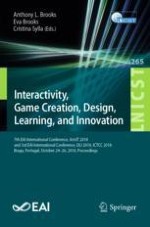This book constitutes the refereed post-conference proceedings of two conferences: The 7th EAI International Conference on ArtsIT, Interactivity and Game Creation (ArtsIT 2018), and the 3rd EAI International Conference on Design, Learning, and Innovation (DLI 2018). Both conferences were hosed in Braga, Portugal, and took place October 24-26, 2018. The 51 revised full papers presented were carefully selected from 106 submissions.
ArtsIT , Interactivity and Game Creation is meant to be a place where people in arts, with a keen interest in modern IT technologies, meet with people in IT, having strong ties to art in their works. The event also reflects the advances seen in the open related topics Interactivity (Interaction Design, Virtual Reality, Augmented Reality, Robotics) and Game Creation (Gamification, Leisure Gaming, GamePlay).
ArtsIT has been successfully co-located with DLI as the design, learning and innovation frame the world of IT, opening doors into an increasingly playful worlds. So the DLI conference is driven by the belief that tools, techniques and environments can spark and nature a passion for learning, transformation domains such as education, rehabilitation/therapy, work places and cultural institutions.
